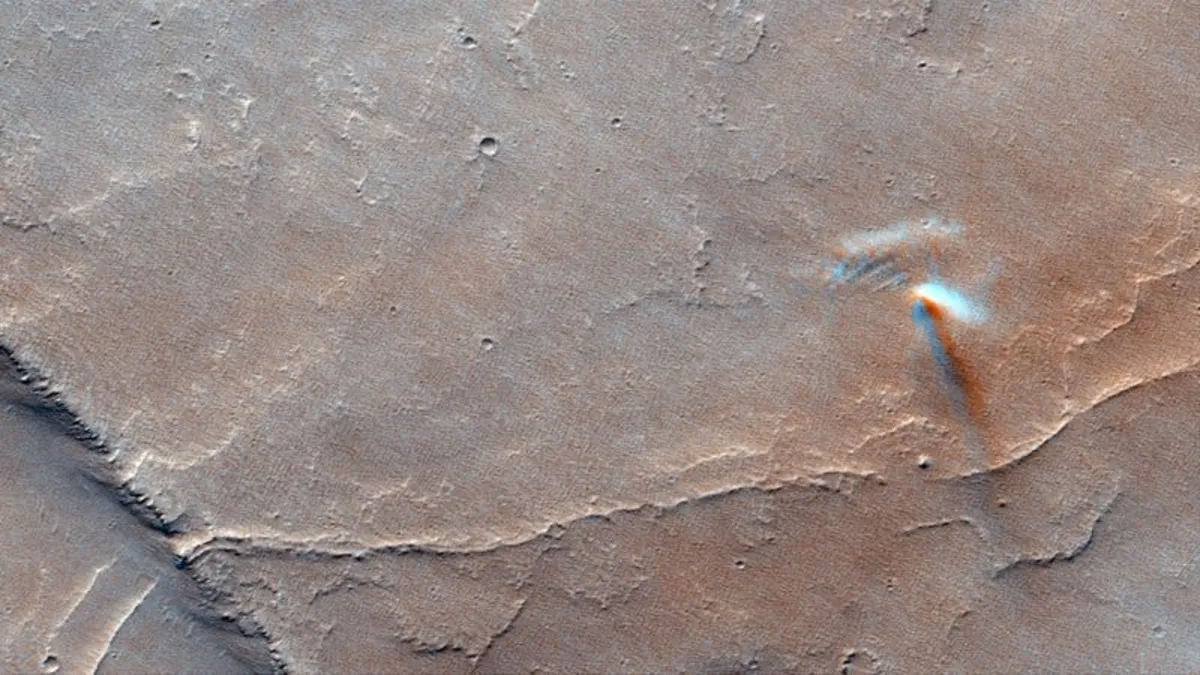
For the past twenty years, two orbiters circling Mars have provided groundbreaking insights into the planet's climate and atmospheric dynamics, revealing the existence of intense winds that contribute to a phenomenon known as dirt devils. These dust-filled whirlwinds remain largely invisible but are identified through the movement of Mars' iconic red dust. A recent study published in the journal Science Advances catalogs these Martian dust devils, highlighting their speed and frequency compared to their terrestrial counterparts.
Dust devils, which are tornado-like whirlwinds, are common on both Earth and Mars. However, according to lead study author Dr. Valentin Bickel from the University of Bern, Martian dust devils move significantly faster and are more prevalent globally. The research team utilized imagery from the European Space Agency’s Mars Express since 2004 and the ExoMars Trace Gas Orbiter since 2016 to compile a catalog of 1,039 dust devils. This effort involved training a neural network to identify the dust vortices in the orbital data, providing crucial insights into the Martian atmosphere.
The study found that Martian dust devils can reach speeds of approximately 99 miles per hour (160 kilometers per hour), significantly faster than those previously recorded by rovers on the Martian surface. Dr. Bickel noted, “This observation suggests that these winds are likely capable of lifting substantial amounts of dust from the surface into the atmosphere,” enhancing our understanding of the Martian dirt cycle. Understanding the movement of dust on Mars is critical for planning future robotic and human explorations of the red planet.
Studying dust on Mars offers scientists a unique avenue to model the planet's climate without direct observation from the surface. Unlike Earth, where rain clears dust from the air, Martian dust can remain suspended in the atmosphere for extended periods, impacting surface temperatures and climate patterns. The new findings suggest that dust devils may play a more significant role in transporting dust into the Martian atmosphere than previously believed.
Research indicated that many dust devils were concentrated in the Amazonis Planitia region, known for its flat terrain and dust coverage. Dr. Bickel explained, “Amazonis Planitia provides ideal conditions for dust devil formation, being a vast, flat region that receives ample sunlight during the summer.” The study also revealed a seasonal aspect to dust devil activity, with increased formations during the spring and summer months in both hemispheres.
Although neither orbiter is equipped with instruments explicitly designed to measure wind speeds, Bickel and his team discovered valuable data amidst what might typically be considered noise. By analyzing images generated from different channels, they could detect the movement of dust devils and measure their speed. Colin Wilson, ESA project scientist for both orbiters, emphasized the significance of dust, stating, “Dust affects everything on Mars — from local weather conditions to how well we can capture images from orbit.”
The compiled database estimates that dust devils lifted between 2,200 and 55,000 tons of dust into the Martian atmosphere from the northern hemisphere, and between 1,000 and 25,000 tons from the southern hemisphere, between 2004 and 2024. These findings indicate that previous climate models for Mars have underestimated the winds responsible for sediment movement on the planet, essential for understanding its geological history.
The findings are crucial for future missions to Mars, as dust can lead to planet-encircling dust storms that have historically impacted missions like Opportunity and InSight. Interestingly, dust devils have also been beneficial in clearing dust off solar panels of rovers. The data collected will continue to be updated, serving as a resource for future mission planning and helping scientists predict wind conditions at potential landing sites.
Understanding Martian dust dynamics is not only vital for the success of robotic missions but also for future human exploration. Dr. J. Michael Battalio from Yale University emphasized that these observations could validate and improve weather models for Mars, ensuring the safety and durability of future missions. Furthermore, studying Mars offers insights into Earth’s climate, as researchers can compare atmospheric dynamics across the two planets.
In summary, the comprehensive catalog of Martian dust devils enhances our understanding of the red planet’s atmosphere and climate. This research opens new avenues for exploration and provides critical information necessary for planning future missions to Mars, ultimately deepening our understanding of our neighboring planet.